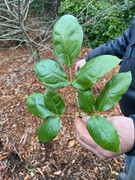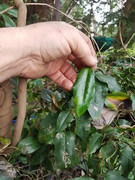OK! I dug out my old notes on this one, and learned a few more things! I really appreciate the discussion on this thread. It's really important for us to know the safety of our hobby

.
Pomper et al. looked at the toxicity of soursop, cherimoya, pawpaw varietals, peach, and banana:
https://pubs.acs.org/doi/abs/10.1021/jf9018239. They measured toxicity by finding the amount of extract needed to kill 50% of a brine shrimp population. Among many things, they found:
1) that cherimoya flesh was 100x less toxic than soursop, and is almost as benign as peaches (yay!).
2) that some pawpaws were 100x more toxic than soursop, and that some pawpaws were about as toxic as soursop.
The amount of annonacin in some pawpaws is truly staggering! But, itís this dramatic figure which likely proves the point that this is rather well tolerated by >99% of the population. A homeowner binge-eating fruit from their pawpaw tree could end up eating ~3lbs of pawpaw in a day (or 3~5 pawpaw fruits). Assuming a typical soursop weighs 6lbs, thatís roughly like eating 50 soursop fruits in a single day! A single tree could yield 30~80 pounds of fruit, so that could amass to eating the equivalent of 500~1300 soursops per tree. Thatís a dose higher than eating a full 6lbs of soursop every day *and* drinking the soursop leaf tea every day for a year, but administered all in 1~2 months! If thatís the case, fruit fanatics and pawpaw lovers in the american midwest should be suffering just as much or more than the people of french west indies due to the Indiana banana!
However, there are definitely a small population of people who ARE very strongly affected by this toxin: people with Progressive supranuclear palsy (PSP). Developing this extremely unfortunate condition is mostly strongly linked to genetics. In caucasians, the insertion/deletion polymorphism in intron 9 of MAPT is associated with this risk. In Guadeloupe, it's likely some other genetic issue (
https://movementdisorders.onlinelibrary.wiley.com/doi/abs/10.1002/mds.22297).
Caparros-Lefebvre found in 2005 that younger people who were diagnosed with PSP greatly diminished their PSP symptoms when they stopped consuming annona products. I don't have access to the original paper, but you can see it on slide 14 here:
http://www.pawpaw.kysu.edu/PDF/AcetoUpdate3.pdf.
Since the caucasian farmer in the 2020 paper had been diagnosed with PSP, and likely had the H1 genetic factor, he definitely should not have been consuming annona fruits or products. It's unfortunate that this wasn't more well known! He lived to be 80 years old, which is pretty good, but he could have lived longer. What he likely experienced was a huge surge in symptoms every time he consumed pawpaw. Since symptoms were only observed to diminish in younger people with PSP when stopping annona products, he may have felt a permanent increase in the severity of his symptoms whenever he consumed pawpaw. It's unfortunate that he didn't make the connection that his symptoms got worse when he ate the fruit.








 . Let me know if anyone wants to trade locally!
. Let me know if anyone wants to trade locally!